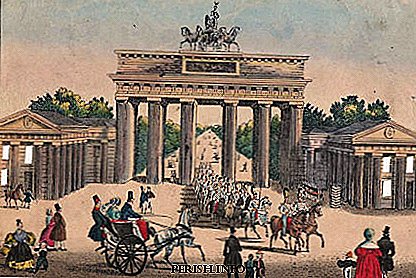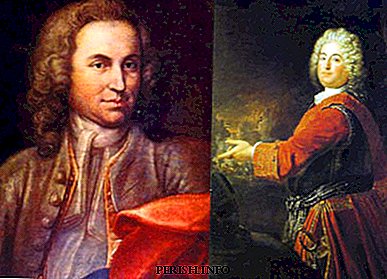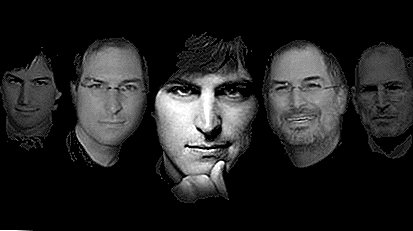I.S. Bach "Brandenburg Concerts"

Monumentality, architectural style and the shape of the form distinguishes Johann Sebastian Bach among other composers of the first half of the 18th century. Skillful possession of composer's craft allowed the creator to create the greatest works, which are still considered to be magnificent monuments of world classical culture. The six Brandenburg concerts are a historical legacy given to us by the great genius Johann Sebastian Bach. You can get in touch with the eternal, enjoy listening to music performed by the best orchestras of the world, read the history of creation, interesting facts and musical characteristics on this page.
History of creation
There are several versions of the dating of Bach and the Margrave of Brandenburg. According to one of them, in 1718 Johann Sebastian Bach went to Berlin. The purpose of the trip was to acquire high-quality harpsichord for the court chapel. While in Berlin, Bach was lucky to meet Christian Ludwig of Brandenburg.
Margrave was a big fan of the composer. During the conversation, the aristocrat expressed a desire to receive as a gift a piece of music in the style of Italian concerts, but with features inherent in German classical music. Christian Ludwig was a rich man and contained a magnificent orchestra, to compose for which was a great honor. Returning to Kothen, in the hope of obtaining the post of court composer, Johann Sebastian Bach began to compose concerts, later named after the margrave. The cycle of six concerts in 1721 was completely over. Then the composer experienced the black page of his life. Thoughts about the briefly deceased Maria Barbara, his wife, did not give him rest. It was necessary to think about how to raise four children to their feet. The intention to get a position in Berlin was a great chance to start life from scratch, and be able to give the children the necessary education.

On March 24, the composer signed the composition and sent it to the Margrave of Brandenburg. The musician independently rewrote the rough notes in a calligraphic hand, but hopes were not justified. Having received the work, the margrave was very grateful to Bach, but he did not suggest the place of the leader of the orchestra. The court orchestra has never performed works, since it was reduced to six people. After the composition was forgotten and transferred to the library to other works created specifically for the margrave.
For more than 100 years, notes have been gathering dust in the margrave library. They were discovered by chance, the find was invaluable. The found manuscript has been published. Since then, the Brandenburg Concerts have been constantly performed by the best chamber orchestras in the world.
Interesting Facts
- The first part of the First Brandenburg Concert is recorded as one of the best creations of mankind on the Voyager gold record.
- In the sixth concert, the composer uses ancient instruments, namely Viola da Braccio and Viola da Gamba.
- The second part of the third concert consists of just one measure. Often replaced by sonata BWV 1021.
- Writing works, Bach wanted to get the seat of the court leader of the orchestra.
- The Brandenburg Concerts were named by the famous theorist Philippe Spitta, who devoted an enormous number of years to the study of the biography of Johann Sebastian Bach.
- The unusualness of the first and third concerts is that there is no solo instrument in them.
- The first concert has an earlier version, which contains the use of the predecessor of the horn Korno and Kachcha - this is a hunting instrument, which was played after a successful hunt.
- In the dedication, the composer indicated that the work was written for several instruments. It was a very modest definition, as the concerts were richly orchestrated. It was a large number of instruments in the score that prevented the execution of compositions within the walls of the margrave concert hall.
- Judging by the number of copies found by the researchers, in the times of Bach the Fifth concert was especially popular.
Content

The structure of the works in the cycle, in accordance with the wishes of the customer, was close to the famous Italian samples concerto grosso. The moment of competition between musicians in virtuosity, which is the basis of the genre, was not lost. Nevertheless, virtuosity gives way to enhancing the contrast of musical themes, creating a greater dramatic effect. Innovation in the genre could not go unnoticed when the notes were found 100 years later, many music critics never ceased to be surprised at how unusual and new musical language is. The four-part composition of the first concert anticipates the creation of a classical symphony.
First concert (F-dur) consists of four parts, located in contrast. The orchestration is unusual: 2 French horn, 3 oboe, bassoon and string group, the solo role is given to wind instruments. The first part of the rapid Allegro is a genre-everyday character. The fanfare melody of the horns is a spectacular decoration of the piece. High-rise texture does not create a weighty image, but rather helps to create a feeling of open space.
The second part of the concert, Adagio, is miniature in size, but extremely expressive. There are no French horns in the orchestration. The virtuoso oboe part, the solo melody is rich in modulations, the timbre coloring adds to the image of lyricism and pastorality.
The third part - Allegro continues the imagery of the first part. The unity of the musical material is reflected, first of all, in the orchestration with the prevailing brass band, the intonation connection is also traced. Music is striking in its colorful and swiftness. The rhythm and vigor of the number charges from the first note.
The fourth part is the Minuet, characterized by a wealth of musical material. But this is not a royal dance, which is danced by gallant gentlemen and ladies in a luxurious hall. This is a picture of a rural holiday, with its colorful. Thumbnails are replaced one by one. On this cheerful and upbeat note, the first Brandenburg concert ends.
Second concert (F-dur) forms a classic three-part cycle for the genre. The piece is written for trumpet, flute, oboe and string group instruments. The choice of such solo instruments reflects Bach’s innovative view of the concert genre, before him only a small number of composers were decided to entrust the solo role to several winds. The sound is unusual and full.
The festive Allegro opens with a joint sound of the presented instruments. The high sound of the flute with virtuoso trills is replaced by the sound of the trumpet and oboe. The violins create a background sound in harmony with the brass band.
Andante is written in a minor key - d-moll, which allows you to convey an elegiac, a little melancholic mood. The part is based on two expressive, flowing themes. The pastoral trills of the oboe and flute give the musical image an even more sad character.
Allegro assai is written in the form of a fugue. It features a developed and virtuoso part of the pipe, which acts as a solo instrument. The polyphonization is traced from the very beginning of the composition, the theme is set on the trumpet and cello and continues to the oboe. Copper timbre at a fast pace creates a cheerful mood and gives the listener a feeling of lightness. Especially decorated with the use of chemist.
Third Concert (G-dur) consists of three parts and is written for the string group of instruments, its main feature is the absence of a solo instrument. It is considered a prototype of string quartets.
Allegro is an endless stream of musical thought. The melody is presented at once with several instruments. Texture, relief and festivity - three whales that hold a musical composition.
One of the most unique examples of shortness is the sister of talent. The second part of Adagio consists of one measure, which is marked by the Phrygian cadence. In order to restore the principle of alternation of contrasting parts, many conductors replace the sonata BWV 1021, which has the ending with the Phrygian cadence.
Airy Allegro immerses itself in the atmosphere of baroque music. String instruments, sounding in unison. Harmony and improvisation manifest the work as a musical fantasy.

Fourth Concert (G-dur) three-part, built on the principle of contrast, which is a traditional feature of the genre. Violin and flute solo instruments are supported by a string group of instruments. The piece feels the breadth of symphony space.
Allegro is significantly different from the first parts of other concerts. It has a more lyrical character, devoid of pathos and pomposity.
Andante is a monologue. The violin and the flute intimidate intonation, they are supported by other instruments of the string group, each of which has a unique musical line. It creates a feeling of light sadness.
Presto is a virtuoso five-fugu. Themes are skillfully intertwined with each other, creating a single composition on a thematic basis. Such a craft is subject only to Bach.
Fifth Concert (D-dur). The inclusion of the decorating instrument of the ballet adds virtuosity and colorfulness to the musical image, it does not play the role of accompaniment, in some episodes it soloes. It is the color side of the concert that helped make the piece more popular. many orchestras in those days actively played this music, as evidenced by the countless copies found by researchers.
Allegro has the characteristic genre of competition. The solo instrument is masterfully contrasted with the orchestra. Musical turns, exciting passages in combination with a unique thematism create an unforgettable image of the first part.
Affettuoso is not a match, but a heart-to-heart talk. The lyrical nature of the statements, the full depth can not leave indifferent. Timbral piercing enhances the effect of mourning and anxiety. The drama of the number is opposed to the extreme parts.
Allegro is written in the genre of the ancient dance of Gigue. Stylization finale helps to create an atmosphere of festivity, dance.
Has a special timbre flavor sixth concert (b-dur). The viola da gamba and viola da brachja recreates the baroque sophistication and refinement of the surprisingly soft timbre of the ancient string instruments.
Velvet Allegro plunges into the world of baroque. The refined melody is accompanied by the languid sound of low strings. The absence of violins makes music earthly, but does not deprive it of its height.
Adagio is the silence recorded by the notes. Quiet string trills add dynamism to the music. Awesome cantilena melody actively develops, changes, but does not lose its charm.
Allegro is a worthy finale that combines the freedom inherent in the genre of the concert and, at the same time, a clearly built form, which is typical for German art, including Bach. The music is festive and cheerful leaves a pleasant feeling of what was heard.
The use of music in the cinema
The cycle of compositions is one of the most popular works of Bach today. It is not surprising that many directors use music in their own films.

| Brandenburg Concert | Film |
| №1 | The Red Sparrow (2018) |
| Management Capabilities (2015) | |
| If I stay (2014) | |
| №3 | Man in High Castle (2016) |
| Snowden (2016) | |
| Destruction (2015) | |
| Jobs: An Empire of Temptation (2013) | |
| Puncture (2011) | |
| Halloween 2 (2009) | |
| №4 | House of Cards (2017) |
| Newest Testament (2015) | |
| №5 | Violet (2013) |
"Brandenburg Concerts" is a world cultural heritage perceived as an ethical and aesthetic ideal in the music of those times. The main principle of the composer combining artistic means characteristic of Baroque German culture and the multifaceted form of Italian concerts by Grosso was embodied in the cycle. Bach's concerts along with Vivaldi's concerts are classic examples of the genre.

Leave Your Comment